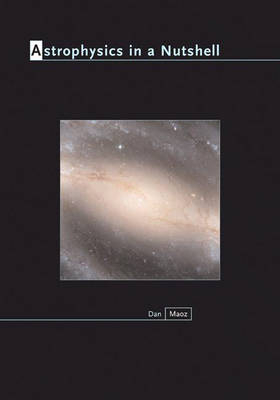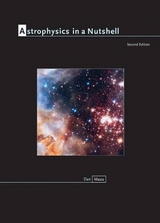
Astrophysics in a Nutshell
Princeton University Press (Verlag)
978-0-691-12584-8 (ISBN)
- Titel erscheint in neuer Auflage
- Artikel merken
A concise but thorough introduction to the observational data and theoretical concepts underlying modern astronomy, Astrophysics in a Nutshell is designed for advanced undergraduate science majors taking a one-semester course. This well-balanced and up-to-date textbook covers the essentials of modern astrophysics--from stars to cosmology--emphasizing the common, familiar physical principles that govern astronomical phenomena, and the interplay between theory and observation. In addition to traditional topics such as stellar remnants, galaxies, and the interstellar medium, Astrophysics in a Nutshell introduces subjects at the forefront of modern research, including black holes, dark matter, gravitational lensing, and dark energy, all updated with some of the latest observational results. To aid physical understanding, mathematical derivations are kept as simple, short, and clear as possible, and order-of-magnitude estimates, dimensional analysis, and scaling arguments are frequently used. These no-nonsense, "back-of-the-envelope" calculations train students to think like physicists.
The book is amply illustrated with simple, clear figures and each chapter ends with a set of problems. In addition to serving as a course textbook, Astrophysics in a Nutshell is an ideal review for a qualifying exam and a handy reference for teachers and researchers. * The most concise and up-to-date astrophysics textbook for science majors * Contains a broad and well-balanced choice of traditional subjects and current research topics * Uses simple, short, and clear derivations of physical results * Trains students in the essential skills of order-of-magnitude analysis * Includes teaching problems with each chapter
Dan Maoz is Professor of Physics and Astronomy at Tel-Aviv University. His main research interests are supermassive black holes, gravitational lensing, and supernovae.
Preface xi Constants and Units xv Chapter 1: Introduction 1 1.1 Observational Techniques 2 Problems 8 Chapter 2: Stars: Basic Observations 10 2.1 Review of Blackbody Radiation 10 2.2 Measurement of Stellar Parameters 14 2.3 The Hertzsprung-Russell Diagram 27 Problems 29 Chapter 3: Stellar Physics 31 3.1 Hydrostatic Equilibrium and the Virial Theorem 32 3.2 Mass Continuity 36 3.3 Radiative Energy Transport 36 3.4 Energy Conservation 41 3.5 The Equations of Stellar Structure 42 3.6 The Equation of State 43 3.7 Opacity 45 3.8 Scaling Relations on the Main Sequence 46 3.9 Nuclear Energy Production 48 3.10 Nuclear Reaction Rates 53 3.11 Solution of the Equations of Stellar Structure 58 3.12 Convection 58 Problems 61 Chapter 4: Stellar Evolution and Stellar Remnants 65 4.1 Stellar Evolution 65 4.2 White Dwarfs 69 4.3 Supernovae and Neutron Stars 81 4.4 Pulsars and Supernova Remnants 88 4.5 Black Holes 95 4.6 Interacting Binaries 99 Problems 108 Chapter 5: Star Formation, H II Regions, and the Interstellar Medium 114 5.1 Cloud Collapse and Star Formation 114 5.2 H II Regions 122 5.3 Components of the Interstellar Medium 133 5.4 Dynamics of Star-forming Regions 136 Problems 137 Chapter 6: The Milky Way and Other Galaxies 140 6.1 Structure of the Milky Way 140 6.2 Galaxy Demographics 162 6.3 Active Galactic Nuclei and Quasars 165 6.4 Groups and Clusters of Galaxies 171 Problems 175 Chapter 7: Cosmology: Basic Observations 178 7.1 The Olbers Paradox 178 7.2 Extragalactic Distances 179 7.3 Hubble's Law 185 7.4 Age of the Universe from Cosmic Clocks 187 7.5 Isotropy of the Universe 188 Problems 189 Chapter 8: Big Bang Cosmology 190 8.1 The Friedmann-Robertson-Walker Metric 190 8.2 The Friedmann Equations 193 8.3 History and Future of the Universe 196 8.4 A Newtonian Derivation of the Friedmann Equations 202 8.5 Dark Energy and the Accelerating Universe 204 Problems 206 Chapter 9: Tests and Probes of Big Bang Cosmology 209 9.1 Cosmological Redshift and Hubble's Law 209 9.2 The Cosmic Microwave Background 213 9.3 Anisotropy of the Microwave Background 217 9.4 Nucleosynthesis of the Light Elements 223 9.5 Quasars and Other Distant Sources as Cosmological Probes 226 Problems 229 Appendix. Recommended Reading and Websites 235 Index 239
| Erscheint lt. Verlag | 25.3.2007 |
|---|---|
| Reihe/Serie | In a Nutshell |
| Zusatzinfo | 21 halftones. 68 line illus. |
| Verlagsort | New Jersey |
| Sprache | englisch |
| Maße | 178 x 254 mm |
| Gewicht | 482 g |
| Themenwelt | Naturwissenschaften ► Physik / Astronomie ► Astronomie / Astrophysik |
| ISBN-10 | 0-691-12584-8 / 0691125848 |
| ISBN-13 | 978-0-691-12584-8 / 9780691125848 |
| Zustand | Neuware |
| Haben Sie eine Frage zum Produkt? |
aus dem Bereich



